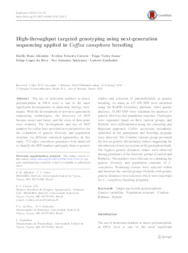High-throughput targeted genotyping using next-generation sequencing applied in Coffea canephora breeding.
High-throughput targeted genotyping using next-generation sequencing applied in Coffea canephora breeding.
Autoria: ALKIMIM, E. R.; CAIXETA, E. T.; SOUSA, T. V.; SILVA, F. L. da; SAKYAMA, N. S.; ZAMBOLIM, L.
Resumo: The use of molecular markers to detect polymorphism at DNA level is one of the most significant developments in molecular biology techniques. With the development of new next-generation sequencing technologies, the discovery of SNP became easier and faster, and the costs of data point were reduced. The development and use of SNP markers for coffee have provided new perspectives for the evaluation of genetic diversity and population structure via different statistical approaches. In this study, 72 Coffea canephora genotypes were analyzed to identify the SNP markers and apply them to genetic studies and selection of parents/hybrids in genetic breeding. As many as 117,450 SNP were identified using the RAPiD Genomics platform. After quality analyses, 33,485 SNP were validated for analyses of genetic diversity and population structure. Genotypes were separated based on their varietal groups, and Hybrids were differentiated using the clustering and Bayesian approach. Coffee accessions mistakenly identified in the germplasm and breeding program were detected. The Conilon varietal group presented the lowest genetic dissimilarity values, suggesting the introduction of new accessions in the germplasm bank. The highest genetic distances values were observed among genotypes of the heterotic groups (Conilon and Robusta). The markers were efficient in evaluating the genetic diversity and population structure of C. canephora. Promising crosses were selected within and between the varietal groups. Hybrids with greater genetic distances were selected, which were important for C. canephora breeding programs.
Ano de publicação: 2018
Tipo de publicação: Artigo de periódico
Unidade: Embrapa Café
Palavras-chave: Hybrids, Polymorphism, Population structure
Observações
1 - Por padrão são exibidas publicações dos últimos 20 anos. Para encontrar publicações mais antigas, configure o filtro ano de publicação, colocando o ano a partir do qual você deseja encontrar publicações. O filtro está na coluna da esquerda na busca acima.
2 - Para ler algumas publicações da Embrapa (apenas as que estão em formato ePub), é necessário ter, no celular ou computador, um desses softwares gratuitos. Sistemas Android: Google Play Livros; IOS: iBooks; Windows e Linux: software Calibre.
Acesse outras publicações
Acesse a Base de Dados da Pesquisa Agropecuária (BDPA) para consultar o acervo completo das bibliotecas da Embrapa.

